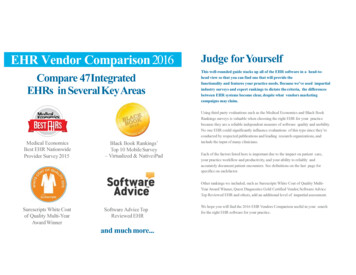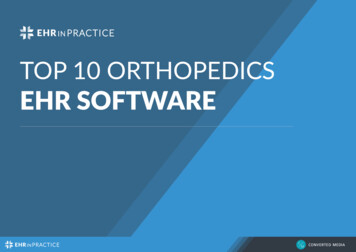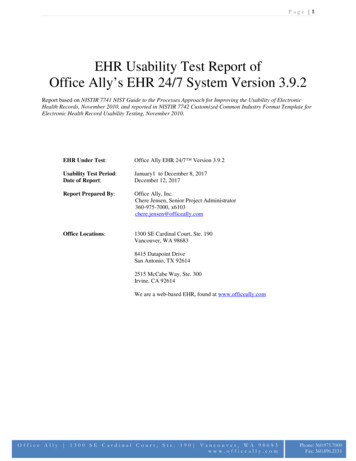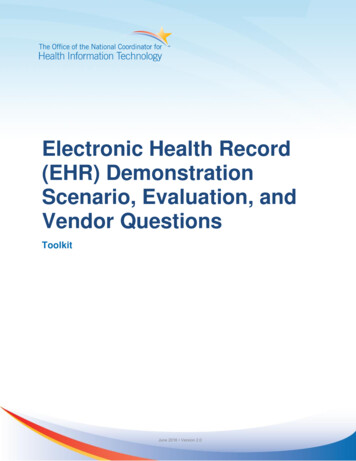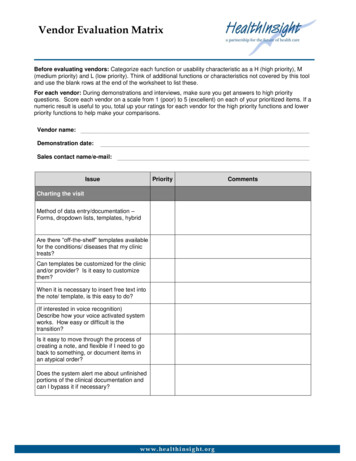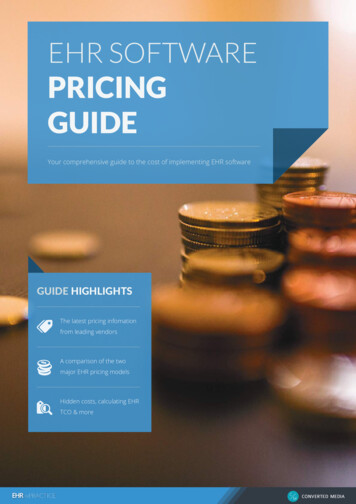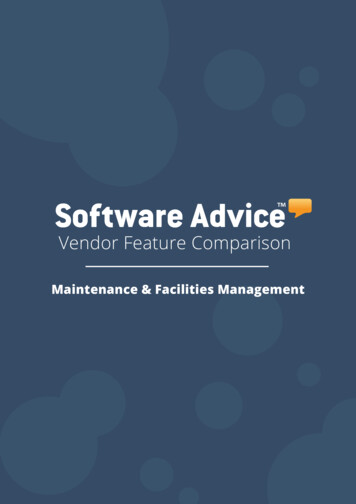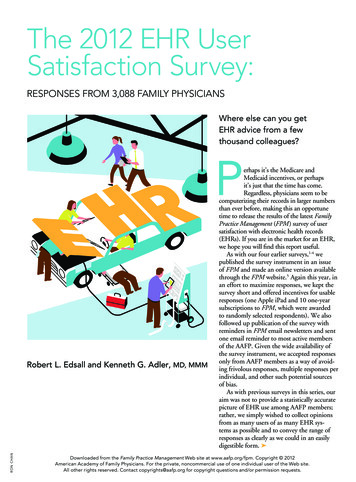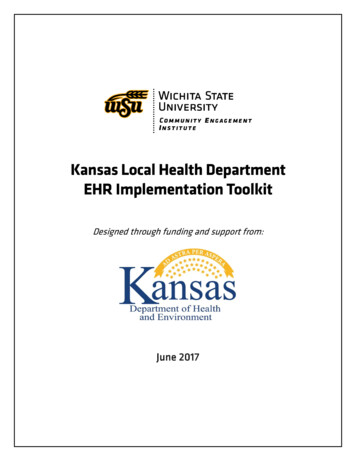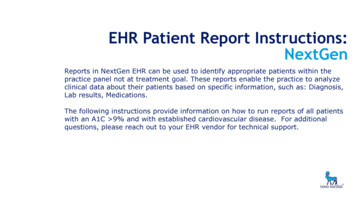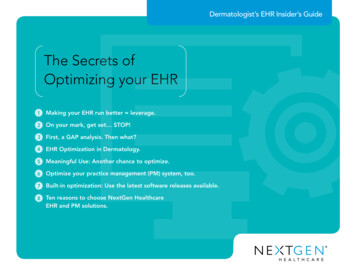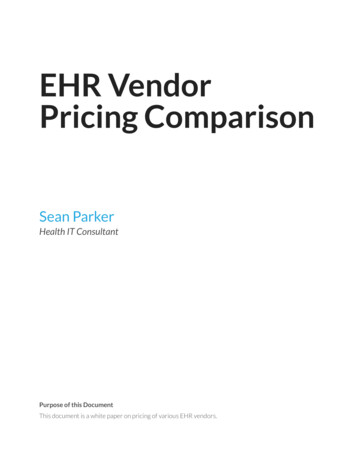
Transcription
EHR VendorPricing ComparisonSean ParkerHealth IT ConsultantPurpose of this DocumentThis document is a white paper on pricing of various EHR vendors.
EHR Vendor Pricing ComparisonWith an evidently growing number of EHR users in the HIT market, the vendors providingthese EHRs are steadily growing. Setting aside billions as stimulus money, the federalgovernment has given physicians substantial incentives to switch to EHRs.As there are practically more than a 1,000 Electronic Health Record vendors in the market,practices are facing a tough time deciding which vendor to go for.As an independent consultant, I was commissioned by a well-known practice to evaluate EHRvendors in the market. I used primary research methods such as first-hand interviews, telephone interviews and live product demonstrations. Independent research organizationswere consulted to compare different EHR vendors.The following EHR vendors were NextGen5.Practice FusionI’ll guide you through the process I experienced while trying to get a pricing from eachvendor.2
Vendors Practice Fusion3
1.AthenahealthAthenahealth is a web-based provider of EHR, PM and billing, often ranked amongst the top10 vendors in the market.Calling Athenahealth resulted in a call-back from the sales team after around 5 hours. WhenI asked for pricing, I was told that I would have to sit through a 30-minute productdemonstration before I could get a quote. Meanwhile, I tried to find Athenahealth's pricingon their website but couldn't find anything. A couple of days later, after having set up aconference call with one of their sales managers, I was able to see the product and found outthat they follow a business model that mainly charges clients for their billing services, theamount which includes (and makes you eligible for) their integrated EHR and PM services.So, if you require a standalone EHR or PM, you cannot do that with Athenahealth- you willhave to get their Billing services first.After further research, I found out that Athenahealth does not have free technical support,and its users have been facing usability issues due to the system becoming complicated. Theyhave poor customer support, and charge separately for even the most trivial services.VerdictAthenahealth is a good company to work with if you are a hospital or a multiple-physicianpractice as the cost is divided evenly. However, it has been designed keeping in mind theworkflow of large practices and might not have the best user experience for small ones.Athenahealth charges 4—7% of the total practice revenue for their billing services, whichincludes the rest of its products. Due to their high prices, and the fact that they charge extrafor other products and services, Athenahealth is not good for small-to-medium scaledpractices who cannot afford to pay separately for simple additions to the software.4
2.eClinicalWorkseClinicalWorks, like Athenahealth, has started featuring in the top EHR category in the pastfew years. The company has done well in terms of marketing itself in trade shows and in theindustry with a highly persuasive sales team willing to give you a demo in the comfort of yourhome-even at odd hours. Thus, in terms of the sales and marketing efforts, Kudos to theeClinicalWorks team.I only wish that the product and service was as great. I have been in contact with a lot ofdisgruntled users complaining about their lack of support. A friend of mine, who had usedeClinicalWorks at his small-scale practice, fumed at the company and said that itsinconsistency was unparalleled. For example, some keyboard shortcuts, which workedperfectly fine in some templates, did not work in others, and some keyboard hotkeys, whichare standard across all software, resulted in random results.They advertise a standard charge of 2.9% of annual billing collections for their clients.However, what they do not mention is that you must be earning a specific amount ofmoney each month to qualify for this. Make sure to question them about this. In my opinion,after looking at an eClinicalWorks price comparison, the actual cost eventually amounts tothe standard 4 - 7 % rate in the market and is just brilliant marketing rather than a good dealfor the practice. Also, their recent Version 10 upgrade has many bugs which the company hasbeen slow to address, leading to unhappy customers.VerdicteClinicalWorks has shown tremendous growth over the past few years. However, I amskeptical whether this growth has been due to the quality of their product or just a brilliantmarketing and sales strategy.5
3.CureMDCureMD provides EHR and PM solutions in a bundled suite, along with a Billing service thatutilizes their own in-house clearinghouse.In terms of market share, CureMD is not the same size as perhaps Athenahealth, but fromwhat I saw in the software, they have a robust system that is user-friendly and interoperablewith affordable pricing options. Their new version 10G boasts of a highly usableinterface that, according to some doctors who have tried, is of very good quality.Looking through their website I found the pricing options easily. I found out that they havetwo separate pricing options for physicians (with upfront cost and with no upfront cost). Thisis a good pricing model as it gives physicians the flexibility to choose a suitable pricingpackage.In terms of the product, the system seems easy to use. What really vowed me was CureMD’sinbuilt E&M code calculator. Once a physician signs a provider note, you can simply click abutton to generate the correct level of visit. Moreover, if you want to increase the E&M code,the system will recommend the exact way to do so. Their support has received good ratingsin independent research organizations such as KLAS.The downside to CureMD is that their marketing strategy has been based on internalreferrals or targeting physicians only in the East Coast. Thus, there are not a lot of physiciansaware of CureMD in the rest of the country. Subsequently, physicians automatically assumethat CureMD is a small EHR vendor even though that is not the case. CureMD is a goldpartner with Microsoft and promises best functionality on any Windows-based system. Thisraises a red flag for many Apple users; however I later found out that they cater to the iOSplatform as well.6
VerdictCureMD has a good customer support. Everything is in-house, and there are no third partiesinvolved. They even have their own clearinghouse and don’t charge you separately. I recentlycame across an article and was surprised to see CureMD along the top 10 EHR vendors suchas Athenahealth and McKesson, ranking in the top three for solo, small and medium sizedpractices.The implementation period for the West Coast is slightly longer than from the rest of thecountry and takes 6-8 weeks to take the practice live, compared to 3-6 weeks in the EastCoast.CureMD caters to all specialties except dental.7
4.NextGenNextGen is a server-based provider of EHR and PM solutions for providers and hospitalsonly. Their system is Meaningful Use Stage 2 certified and boasts of a large user-base.It was fairly easy to connect with a sales executive, who ran me through the system. Fromwhat the executive told me, along with further research, I found that the product was veryexpensive. One of the things that really bothered me was that NextGen required an upgradeto ICD-10. The system is already very difficult and not suitable for solo, small or medium-sized practices.Reviews in clinical circles revealed that NextGen system not intuitive, unstable, and hasmany known issues. Their EHR is highly priced and has major functionality issues such as nocustomized dashboards.VerdictBeing a very large provider, NextGen needs to up its game, work on its product, and increasetheir satisfaction ratings, which are continuously falling. They have iron-steel contracts thatmake it very difficult for existing customers to have access to their own data once theydecide to switch their system.8
5.Practice FusionPractice Fusion is known in the industry as a vendor that provides free software and makesmoney through its marketing services. They have a huge user-base and cater to manyspecialties with a business-model that revolves around advertisement.On my fourth attempt, I finally got in touch with a sales representative who talked methrough the company’s history and what it offered.Practice Fusion provides free web-based EMR and PM solutions. Their only product is theEMR, while they provide a PM service through Kareo. This actually changes the dynamicsbecause when you get EMR PM from Practice Fusion, you will have to deal with twodifferent vendors – something which is painstaking if you face issues with the software.Overall, it’s an annoying experience dealing with two different vendors. What if you have aproblem? Who do you go to? What if Practice Fusion and Kareo decide to part ways, whatwill you do then?Users who have been using Practice Fusion have faced interoperability issues, poor support,lack of control over data, faulty mobile application and user-interface issues such as noflow-charts and difficulties in adding immunizations.VerdictPractice Fusion is highly appealing because they offer free software where as other vendorscharge for it. They also have a really attractive and easy-to-use website. However, lookingover some reviews on the internet had me wondering how many people actually liked theproduct and I found mixed reviews. Users had a common problem with a lack of functionalityand buggy software.9
However, to give the devil its due, the basic EHR is free and if your practice is looking to usethe system for storing basic patient information and work on generic provider notes,Practice Fusion may be a good place to start. I would however, not recommend this productfor specialties which require additional functionalities such as Pediatrics, Oncology, OB/Gyn,Dermatology, Cardiology etc.Practice Fusion recently came up with the final version of their iPad application which is aplus for iPad users. The application allows clinical data entry and enables providers to workon their notes directly from the iPad. However, it is still too early to comment on how goodthe product is.For physicians looking to select an EHR for their practice, they should keep in mind that theEHR they choose must be user-friendly, interoperable, certified, Meaningful Use compliant,ICD-10 ready and highly customizable. There are EHRs that you have to pay for, and thereare EHRs that you can get for free. Remember though, free EHRs come at the cost of yourpractice, since they cannot offer the same features, functionalities, and user experience of aproper, paid EHR. When an organization invests in software, it shows in the software, andthat software comes at a price. When an organization does not depend on the quality of itssoftware to get its revenue – they sell it for free.Any one interested to learn more about any vendor, please feel free to drop an email todocseanparker@gmail.com with your practice details.10
EHR Vendor Pricing Comparison With an evidently growing number of EHR users in the HIT market, the vendors providing these EHRs are steadily growing. Setting aside billions as stimulus money, the federal government has given physicians substantial incentives to switch to EHRs.File Size: 259KB
